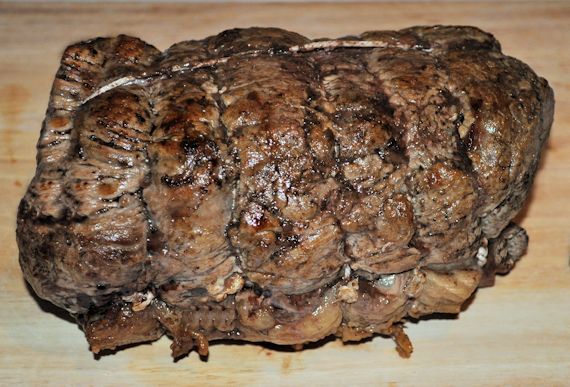We took home a lovely piece of meat from Andrew Gordon Butchery and Fine Foods and had a lovely and luxurious meal fit for a King and Queen.
Questions that people often ask are around how to roast a joint of meat, or how to cook roast beef properly so I thought I’d write it down.
This piece of meat is a new steak that is sweeping the meat-eating population of Aberdeen off their feet. Tempted to try it, I went a bit further and had a whole roast for our Sunday dinner last week.
This picture shows the Gordonian Best Steak Roast in all it’s glory. It is actually upside down as there’s a layer of fat on the other side that allows the roast to drip juices and keep it moist as it cooks. My pictures are upside down to show the effect of the quality of the rich colour in the beef.
As a tender piece of meat, the roasting time can be slightly shorter and at a slightly higher temperature than a cheaper, or less tender roast of beef.
It’s a truly gorgeous piece of meat that anyone would be proud to have on their table for a cracking and filling meal.
The best way to roast a tender piece of meat is going to be in the oven, and after searing all sides in a pan first.
Tender cuts of meat always do well roasted.
The purpose of the roasting is only to use the fat to cook the roast, simply and with the occasional baste (spooning juices over the top) to help it along.
To seal the roast in, the easiest thing is to use a frying or sauté pan to help seal in the juices and help along the crusty and full of flavour outside of the roast.
While you are preparing and sealing your roast, make sure your oven is on to pre-heat. You want the oven nice and hot before it goes in to be finished.
Make sure your roasting pan is big enough to hold your roast, but not as large as the juices all escape and leave you nothing to baste your roast with as it cooks. You really want enough juices left over to make awesome gravy as a trimming.
Cook a roast in the oven to finish off the process at around 180 – 200 C, or Gas Mark 6 for approximately the following times per pound of meat.
– Rare (15 – 20 minutes)
– Medium (20 – 25 minutes)
– Well Done (25 – 30 minutes)
I cooked my roast for the kids, which needed an extra 20 minutes on top of the cooking time to ensure there was absolutely no pink at all in the meat. I know that isn’t the ideal way to cook, nor the way that butchers or chefs would recommend, but any redness at all and my kids won’t eat it.
For fabulous roasts, they really do need to rest after they’ve been cooked. Once it’s cooked, just put it to the side for about 15 – 30 minutes and cover it very loosely with some tin foil to help keep the heat in. Resting lets the meat reach a more consistent texture and helps the meat to be consistently juicy.
Use the juices left over from roasting to make wickedly tasty gravy and serve with veg, and sides. I have to apologise for the lack of plate pictures on this post, as I took a couple of hurried pictures as the family were so hungry, and neither of them came out.
The meat was fabulous. The roast only had a teensy bit left over at the end of the meal, as the man and kids both had seconds.
I had hoped to have enough to make Gordonian Best Steak Roast luxurious stovies the next day, but alas, my boys cleared too much of it at the first sitting.





I have to say that does look good, it is one meat we rarely eat as we have no cattle on our farm.